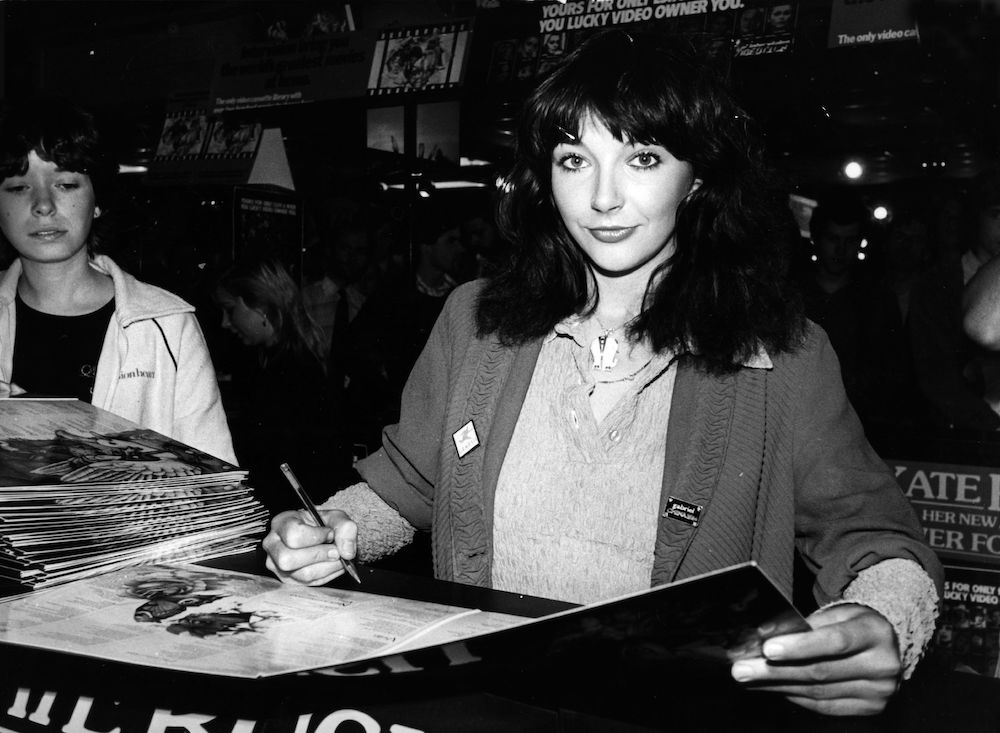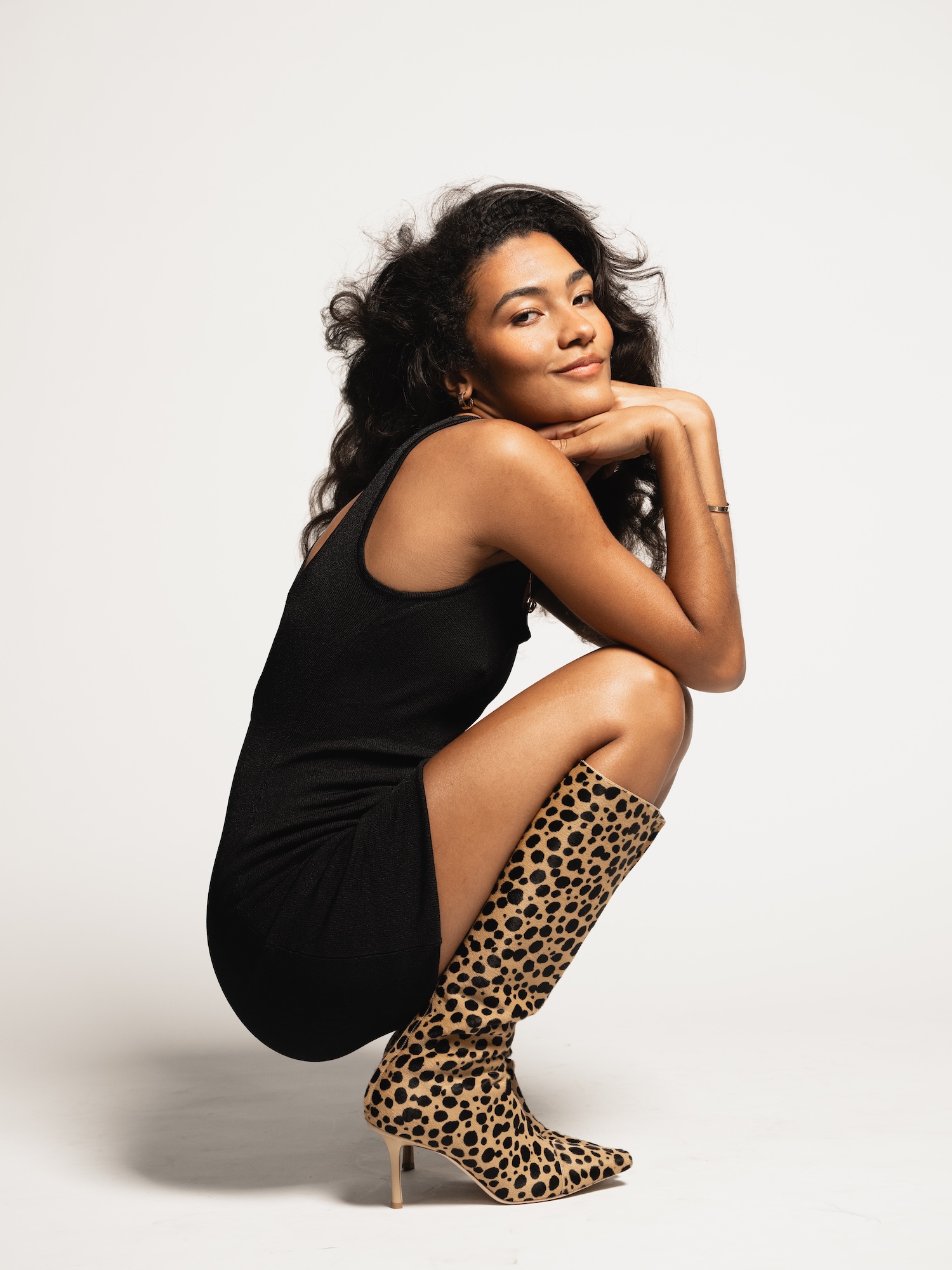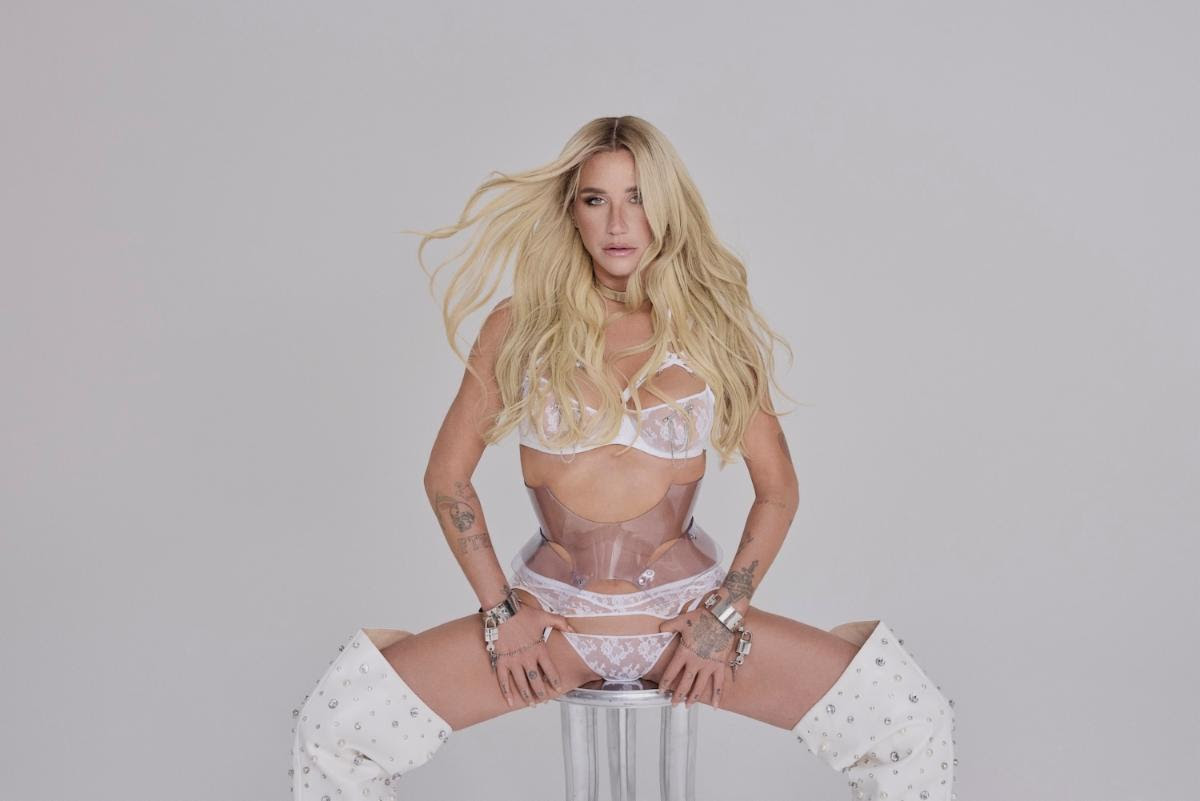In January of this year, music and pop culture writer Ted Gioia wrote an article in The Atlantic titled "Is Old Music Killing New Music?" I think about this piece every time a big TV show nabs a particularly effective needle drop — like Stranger Things did with Kate Bush's "Running Up That Hill (A Deal With God)," which then re-entered the Billboard Hot 100 at #8, becoming Bush's first top-10 single in the US. (As of today it's up to a new peak of #4.) Or when TikTok turned Matthew Wilder's seminal "Break My Stride" into a meme-prank. Or when the platform's users found and subsequently exploded any number of older songs: Fleetwood Mac's 1977 classic "Dreams," Aly & AJ's 2007 hit "Potential Breakup Song," Britney Spears' 2011 cut "Criminal." It even crosses my mind when artists like Bob Dylan, Bruce Springsteen, and Neil Young sell their catalogs for hundreds of millions.
Older music has always found a way to stay in the pantheon, but according to Gioia, these days it's actually pushing new music aside and making life even more challenging for new artists. "Old songs now represent 70% of the US music market, according to the latest numbers from MRC Data, a music-analytics firm," Gioia writes. "Those who make a living from new music — especially that endangered species known as the working musician — should look at these figures with fear and trembling. But the news gets worse: The new-music market is actually shrinking. All the growth in the market is coming from old songs."
Although it's currently sitting at #2 behind Harry Styles' "As It Was," "Running Up That Hill" spent most of last week at #1 on Spotify's Daily Top Songs Global chart. It remains at #1 on the weekly version of the same chart (with 57,221,016 streams between June 3-9) and #3 on Billboard’s Global chart, right behind "As It Was" and Bad Bunny and Chencho Corleone's "Me Porto Bonito." There's been a trickle-down effect, too, to Bush's entire catalog, with Billboard reporting that it has earned 20.6 million US on-demand streams, a 2,506% gain from the previous week.
"Running Up That Hill" — a forever bop, indeed — wasn't the only older song to experience a huge bump these past few weeks. Musical Youth's "Pass The Dutchie" is also getting tons of new streams thanks to it essentially being the theme song to a Stranger Things stoner character named Argyle (played by Eduardo Franco). The 1983 reggae hit has achieved nearly 2 million new streams thanks to Stranger Things, bringing its Spotify total to nearly 70 million.
Ironically, Gioia points to a music industry dinosaur to help prove his point around how little listeners care about new music these days. Ten years ago, he writes, 40 million people tuned into the Grammy Awards. In 2021, "viewership for the ceremony collapsed 53% from the previous year — from 18.7 million to 8.8 million. It was the least-watched Grammy broadcast of all time." This past year didn't do much better — viewership for the 2022 ceremony, according to the LA Times, brought a 4% gain, with about 9.6 million total viewers.
As Billboard’s Andrew Unterberger pointed out this week in a great piece, resurfaced older music isn’t really a new phenomenon. Speaking to chart and radio expert Sean Ross, Unterberger unpacks how "bringback" culture first peaked for a five-year period from the '80s to the '90s, courtesy of high-profile TV syncs, such as Family Ties using Billy Vera And The Beaters' 1981 song "At This Moment" to soundtrack Alex and Ellen's romance, which resulted in the song being reissued in 1986 and topping the Hot 100 in 1987.
Unterberger also cites two popular '80s comedies, Ferris Bueller's Day Off and Back To School, as being instrumental in pushing the Beatles' 1963 song "Twist And Shout" back onto the Hot 100. Key movie placements of the time also helped older songs — Louis Armstrong's "What A Wonderful World" (Good Morning, Vietnam), the Contours' "Do You Love Me" (Dirty Dancing), the Righteous Brothers' "Unchained Melody" (Ghost), Queen's "Bohemian Rhapsody" (Wayne's World) — back into the Hot 100, as did significant radio play from a group of Contemporary Hit Radio DJs and program directors. Later in the decade, Puff Daddy launched a trend of scoring huge hits built on obvious samples, a phenomenon that didn't usually send the original songs back up the charts but represented a similar hunger for the old and familiar.
I think what separates earlier instances of "bringback" culture from the one we’re currently in is that this one feels much more permanent. We might see more microtrends b/w/o dance challenges and memes, but that doesn't take away from the fact that older music is way more accessible for all in 2022 than it was in 1992. That's why "genre-fluid" musicians such as Billie Eilish, Post Malone, and Lil Uzi Vert have been popping up right and left over the last few years. Today’s popular artist frequently draws influence from across the genre spectrum because they've spent their lives immersed in 10 record stores' worth of material. It used to be that rap producers had to go crate-digging to find obscure funk and soul tracks with which to build a new song. Today, it's literally never been easier to find old music and treat it as new.
When it comes to new music, I think both artists and label people have started to look at the ecosystem as a trip to the slots. Pump enough money (new songs) into the machine (TikTok), and you could win the jackpot (land a viral hit). Even well-known names such as FKA twigs and Florence Welch have recently complained about their labels forcing them to do TikTok promo, and Halsey accused Capitol Records of holding new single "So Good" hostage unless it went viral on the platform. For less established artists, the music industry higher-ups like to romanticize this process as a "You could be next!" rags-to-riches scenario. As YouTube's head of catalog Ryan Thornton recently told Billboard:
Part of what excites me about my role is the phenomenon and potential of any song to go viral. Whether it’s because of social trends, short-form video or prominent syncs, the possibility of watching or taking part in a viral hit is an especially fun part of the catalog segment of the industry. I'm also excited about the role YouTube Shorts can play in amplifying these moments even more and for the full circle music discovery experience fans can have all within the YouTube ecosystem.
Psychologically, we also tend to like older sounds more than newer ones. Discussing the '80s mixtape selections in a then-new Guardians Of The Galaxy, a 2014 Mic article notes:
In numerous scientific experiments, researchers have shown that subjects are much more likely to report positive feelings from a given piece of music if they've heard it before. Songs score even higher marks if they can trigger a specific, storied memory -- like a late summer night spent driving around with "Fooled Around And Fell In Love" on the radio. Familiar music is also a much more reliable way for people to induce good moods in themselves — in fact, the emotional centers of the brain are more active when one listens to familiar music.
The act of industry types looking for the next music phenomenon recently got deconstructed in Vox's "We tracked what happens after TikTok songs go viral" video, where data analysts looked at how many new artists actually got signed and went on tour after having a big song rake in organic views and streams. The analysts ultimately concluded that new artists who get big via TikTok have the advantage over labels, as they've already proven their chops minus any label marketing or promotion, which could translate to a bigger cut of the overall profits.
So yes, the next viral streaming phenomenon could literally be anything. Trouble is, that also applies to old music. As Gioia notes in The Atlantic, the entire industry is founded on repeating itself and playing it safe:
In fact, nothing is less interesting to music executives than a completely radical new kind of music. Who can blame them for feeling this way? The radio stations will play only songs that fit the dominant formulas, which haven't changed much in decades. The algorithms curating so much of our new music are even worse. Music algorithms are designed to be feedback loops, ensuring that the promoted new songs are virtually identical to your favorite old songs. Anything that genuinely breaks the mold is excluded from consideration almost as a rule. That's actually how the current system has been designed to work.
By investing in older sounds, the major industry titans are playing the safest bet there is. This new trend of older music tidal-waving new music is technically an updated version of the same tactic. Time is meaningless, and the snake eats its tail.
Now, you might argue that Stranger Things takes place in the '80s and therefore must choose era-appropriate syncs, which may therefore birth a rediscovered hit. There's nothing wrong with that; I personally love that the Gen Zs are so into Kate Bush now. (Do PJ Harvey next!) It feels like cosmic justice that Bush would get a resurgence, given how ahead of its time Hounds Of Love was in the '80s and how famously reclusive she is. I can't think of anyone more deserving. We should always be looking for ways to help Bush cash those royalty checks without having to hit the road, as she has never been about that touring life. But Stranger Things is basically a mish-mashed love letter to all things '80s sci-fi and horror, and its newness is also fundamentally encased in the old. It's part of a similar phenomenon that's been emerging in Hollywood for years, in which sequels, reboots, well-known IP, and tributes to nostalgic favorites have gained something close to a monopoly.
Looking ahead, it seems pretty clear that new music is just not the priority. I can't tell you how many times over the last 10 or so years I've heard publicists complain that no website/blog/magazine wants to cover new music anymore -- and although sites like this one disprove that notion, our posts about new and/or obscure artists are not exactly big traffic drivers compared to our retrospective columns. If a label wants to invest money in a new artist, they'd better have a robust classic catalog to pay the bills. In the meantime, creators will keep pouring quarters into the slot machine, hoping to eventually strike gold, silver, or platinum.

CHART WATCH
Chris DeVille here to inform you that Post Malone has entered his flop era. Maybe a #2 debut isn't a flop by most artists' standards, but Posty is the former streaming champion who once had Stoney and Beerbongs & Bentleys in the top 10 simultaneously for weeks on end, whose most recent album, 2019's Hollywood's Bleeding, spent five weeks at #1. Twelve Carat Toothache, by comparison, enters at #2 with 121,000 equivalent album units including 21,000 in sales -- decent, but not enough to beat a Bad Bunny album released a month ago. That album, Un Verano Sin Ti, returns to #1 for a second nonconsecutive week with 137,000 units, almost all of them via streaming. Live by the stream, die by the stream. (I would not be surprised to see Twelve Carat Toothache hit #1 when its vinyl release arrives, but that's not happening until February 2023.)
Up next in the top 10: Harry Styles at #3, Future at #4, and Kendrick Lamar at #5. Morgan Wallen's Dangerous: The Double Album, in at #6, has now spent 73 nonconsecutive weeks in the top 10. Per Billboard, it surpasses Alanis Morissette's Jagged Little Pill for the second-most all time behind Adele's 21, which spent 84 weeks in the top 10. SEVENTEEN's Face The Sun debuts at #7 with 44,000 units, almost all of them via sales, becoming the K-pop group's first top-10 release. Olivia Rodrigo, Zach Bryan, and Jack Harlow round out the top 10.
Over on the Hot 100, Harry Styles holds on to #1 with "As It Was" for a sixth nonconsecutive week. It's followed once again by Jack Harlow's "First Class" at #2 and Future, Drake, and Tems' "Wait For U" at #3. After rocketing to #8 last week on the strength of heavy Stranger Things placement and becoming Kate Bush's first American top-10 hit, "Running Up That Hill (A Deal With God)" climbs to a new peak of #4 this week -- but you already knew that after reading today's column. According to Billboard, the 36-year gap between the song's release and its arrival in the top five is the longest in Hot 100 for a non-holiday song, by far surpassing the 16-year interim for Queen's "Bohemian Rhapsody."
After Lizzo's "About Damn Time" at #5, Glass Animals' "Heat Waves" at #6, Latto's "Big Energy" at #7, and Bad Bunny and Chencho Corleone's "Me Porto Bonito" at #8, Post Malone and Doja Cat's "I Like You (A Happier Song)" debuts at #9, becoming Posty's 11th top-10 hit and Doja's fifth. (How does Doja only have five top-10 hits to her name? That doesn't seem right.) Rounding out the top 10 is Bad Bunny's "Tití Me Preguntó."
POP FIVE
Demi Lovato - "Skin Of My Teeth"
Pop-punk Demi has arrived, and trust me when I say that we are all the better for it. "Skin Of My Teeth" really goes.
Halsey - "So Good"
After an overwhelming success like If I Can't Have Love, I Want Power, what does Halsey have to do to release music on their terms? "So Good" really lives up to its name -- I hope it serves as a reminder that not every (established!!) artist needs to offer up dance challenges to the TikTok overlords.
BTS - "Yet To Come (The Most Beautiful Moment)"
The K-pop gods continue to spread only good and hopeful vibes on this forward-looking track. Good vibes are in perilously short supply these days, so I'll take any I can get.
Marshmello & Khalid - "Numb"
Every summer needs some kind of escapist "get drunk on a pool noodle" anthem. This might as well be it!
The Chainsmokers & Ship Wrek - "The Fall"
The Chainsmokers have long since accepted their place in the pop-music pantheon, and that's to always be partying like it's 2012. There is something so purgatorial about their brand of dead-eyed, stubbornly unchanging electro-pop -- it's the musical equivalent of Christian Girl Autumn.
NEWS IN BRIEF
- Demi Lovato announced their new album, HOLY FVCK, out 8/19, and a fall tour. [DemiLovato.com]
- Lovato talked about Holy Fvck and played "Skin Of My Teeth" on Fallon. [YouTube]
- Charlie Puth appeared to accidentally confirm a collab with BTS is in the can. [Twitter]
- Las Vegas' iHeart Music Festival announced its 2022 lineup with Avril Lavigne, Halsey, Luke Combs, Maren Morris, Megan Thee Stallion, Morgan Wallen, Sam Smith, and more. [iHeart]
- Ed Sheeran sent two Australian DJs a giant marble penis. [Instagram]
- Zara Larsson acquired her back catalog masters and launched a new label Sommer House. [Clash Music]
- SZA has a new collab with Crocs. [Instagram]
- Tove Lo did "No One Dies From Love" on Seth Meyers. [YouTube]
- Katy Perry sang about food delivery to the tune of Dr. Dre's "Ring Ding Dong" for an Australian app commercial. [YouTube]
- Here's Twenty One Pilots stripping down "Stressed Out" on MTV Unplugged. [YouTube]
- IKEA unveiled its Swedish House Mafia line. [Ikea]
- Machine Gun Kelly descended from a pink helicopter at his Austin tour opener. [Twitter]
- MGK also teamed up with glaive on the new song "More Than Life." [YouTube]
- Anuel AA and Yailin got married. [Instagram]
- NCT DREAM shared a new song and video for "Beatbox." [YouTube]
- Bastille dropped a new song and video for "Remind Me." [YouTube]
- Taylor Swift performed "All Too Well (10 Minute Version)" live during a screening of All Too Well: The Short Film at the Tribeca Film Festival. [Twitter]
- Justin Timberlake joined Chris Stapleton for "Tennessee Whiskey" in LA. [YouTube]
- Pharrell gifted all graduating high school seniors in the DC public school system tickets to his Something In The Water fest. [Twitter]
- Headlining LA Pride In The Park yesterday, Christina Aguilera brought out Kim Petras, Paris Hilton, and "Lady Marmalade" collaborator Mya. [USA Today]
- Post Malone announced the Twelve Carat Toothache Tour. [Twitter]
CLOSING TIME
— no context memes (@weirddalle) June 11, 2022






